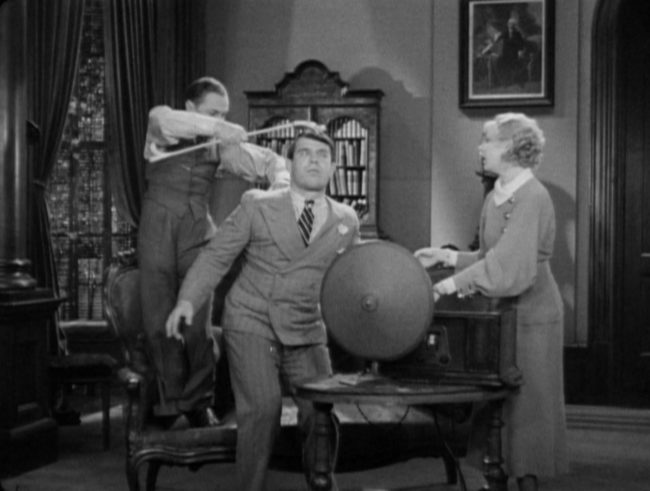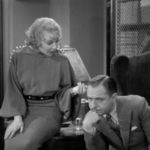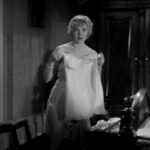 |
 |
 |
| Wallace Porter Ernest Truex |
Toby Van Buren Una Merkel |
Dillon Edward Arnold |
| Released by MGM | Directed by Elliot Nugent Run time: 79 minutes |
||
Proof That It’s a Pre-Code Film
 One gangster named Slim (Johnny Hines) enters to find Lombardo (C. Henry Gordon) with his leg propped up, tying his shoe. Slim gives Lombardo’s hinder a hard look and says, “We ain’t met, but I recognize ya from the descriptions.”
One gangster named Slim (Johnny Hines) enters to find Lombardo (C. Henry Gordon) with his leg propped up, tying his shoe. Slim gives Lombardo’s hinder a hard look and says, “We ain’t met, but I recognize ya from the descriptions.”
- Wallace and Toby had been on the road to elopement when they were kidnapped by gangsters. At one point they barricade themselves in the bedroom, and Toby hints that if tomorrow doesn’t come, she’s sure she doesn’t want to miss out on all that wife stuff she’s heard so much about.
- The plot concerns ‘the perfect murder’, and that caused some problems. Check below in ‘Trivia’ for more.
Whistling in the Dark: An Offbeat Tune
“What have you been doing to my daughter?!”
“Practically everything!”
This is a movie where I had one random thought: this thing would kill at a film festival. Full of an array of early 30s character actors and the ever-lovable Una Merkel, Whistling in the Dark lives up to its a goofy premise: a mystery writer is kidnapped by gangsters and forced to dream up the perfect murder for them to execute.
The writer, Wallace (Truex), isn’t quite nebbish, but he’s the kind of character who drinks a little much and can’t keep his mouth from moving. Accompanied by his fiancee, Toby (Merkel), they are trapped in a mansion with plenty of murderous thugs hanging out behind just about every curtain. Dillion (Arnold) is the main heavy, though sinister Charlie (John Miljohn) and dopey Joe (Nat Pendleton, of course) are also around for when Wallace gets any bright ideas.

This is actually a pretty good representation of my own evenings, though Una is never there in person.
The movie has a number of nice touches– Toby, held by murderers and thieves, is also severely horrified to discover that Joe slurps his soup. One scene, where Wallace finally comes up with the perfect murder struck particularly close to home; he finds himself unable to write with his wife looking over his shoulder, and eventually must simply cover up his eyes so he won’t notice her intent staring.
Ernest Truex was new to me in this film, and his careful double takes were delightful. More astute film fans may recognize him as the man who has his desk stolen by Cary Grant in His Girl Friday, but he had a long career in silents and talkies. He plays the part a bit fey. Compared to the masculine murder machines that the gangsters represent, he’s a mouse who made the mistake of puffing up his chest a bit too much.
Una Merkel, who probably had the most unsuccessful bedroom encounters of any female actress of the early 30s, doesn’t get the entirety of the comedic burden, but gets some good moments. She is a bit smarter than usual, though she is still in the second fiddle role. She does get one nice moment where she almost saves the day, but a dopey move nearly dooms her character. Still, as the almost eternal second banana, she helps the movie immeasurably.
I did want to point out the film’s climax, which uses a 1930s radio in a highly improbably manner, is a wonder to watch nowadays, especially since all of the functions here that require a relay race of back and forth can be accomplished in a palm-held device that can also allow me to watch music videos on YouTube is crazy to ponder.
Whistling in the Dark is a pleasant comedy. It’s not very ambitious– I honestly spent most of the film thinking it was a 1931 release since it contained relatively few sets and rare camera movements–but Truex’s deadpan stylings make this a nice watch for a quiet, cool evening in.
Gallery
Click to enlarge. All of my images are taken by me– please feel free to reuse with credit!
Trivia & Links
- Based on a stage success that ran on Broadway from 1932-33; the stage show also starred Truex and Arnold. Remade in 1941 with Red Skelton in the lead. The Skelton version was successful enough to spawn two sequels, Whistling in Dixie and Whistling in Brooklyn. Warner Archive has that entire trilogy available here.
- The film’s notes from AFI cover one controversial aspect of the film that might not be so apparent to a modern audience; it does a really good job of explaining how just to murder someone. They elaborate:
Files in the MPAA/PCA Collection at the AMPAS Library indicate that, prior to production, the Hays Office expressed concern that the scenes dealing with the plotting of “Barfuss'” murder were too graphic and exact. In particular, the Office was concerned about repeated references to the specific poison to be used in the crime and descriptions of its application. In a letter dated December 7, 1932 to M-G-M production head Irving G. Thalberg, Dr. James Wingate, Director of the Studio Relations Office of the AMPP, suggested that the poison be mentioned only once in the picture and also cautioned that “scenes between Wally and Toby concerning spending the night” be handled with care. He notes that “the presence of the bed ought not to be emphasized since the censors are becoming increasingly sensitive about this item of furniture.” When New York State censors screened the finished film, they demanded that the murder plotting scenes be cut significantly before they would allow the picture to be distributed. W. D. Kelly of M-G-M’s New York office complained to Wingate that the local censors were taking the film too seriously-that “they see and hear the picture…without an audience and without reaction of any kind.” Kelly added that, after attending a performance of the stage play and hearing the audience’s laughter, he was convinced that no harm could come of the murder plotting scenes. Although Kelly’s argument persuaded Irwin Esmond, New York State’s Director of Censorship, Motion Picture Division, to drop the matter during production, MPAA/PCA records show that the New York censors continued to demand eliminations during the film’s release.
- Fantastic Movie Musings calls it “mild”.
- The New York Times review here by Mordaunt Hall is full of praise… but it really goes into the miracles of film make-up in de-aging people. No, really:
Through the improved ideas in make-up and the super-panchromatic film the camera is less harsh on faces over 40 than it was in the days of silent films. This is an emphatic advantage to Mr. Truex. who is 42, for even in close-ups he looks just as well and, one might say, quite as youthful as he did several years ago.
Awards, Accolades & Availability
More Pre-Code to Explore





























2 Comments
Patricia Nolan-Hall (@CaftanWoman) · April 24, 2017 at 11:07 am
My son loves the Skelton version and despite all the times he’s put it on a loop, I didn’t realize it was based on an earlier film. I gotta check it out.
Truex was all over TV when I was a kid so I always think of him as an older man. Always surprises me to see him in this part of his career. He’s a hoot in 1939s It’s a Wonderful World, a comedy I enjoy more than others.
Ellen · May 4, 2019 at 7:03 pm
I’m probably one of the few people who is driven crazy by Red Skelton. I had seen his version of this movie before, but didn’t know there was an earlier version until it popped up on TCM. I had to hop over here to get your take on it. I enjoyed it as much as you did. Ernest Truex made a fun, if unlikely, hero, and he and Una played very well off each other. After doing a bit of research, I found that both Truex and Edward Arnold originated these roles on Broadway.
Comments are closed.